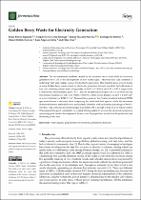| dc.contributor.author | Rojas-Flores, Segundo | |
| dc.contributor.author | De La Cruz-Noriega, Magaly | |
| dc.contributor.author | Nazario-Naveda, Renny | |
| dc.contributor.author | Benites, Santiago M. | |
| dc.contributor.author | Delfín-Narciso, Daniel | |
| dc.contributor.author | Angelats-Silva, Luis | |
| dc.contributor.author | Díaz, Felix | |
| dc.date.accessioned | 2022-07-18T16:40:32Z | |
| dc.date.available | 2022-07-18T16:40:32Z | |
| dc.date.issued | 2022-05-27 | |
| dc.identifier.uri | https://hdl.handle.net/20.500.13067/1964 | |
| dc.description.abstract | The environmental problems caused by the excessive use of fossil fuels for electricity generation have led to the development of new technologies. Microbial fuel cells constitute a technology that uses organic sources for electricity generation. This research gives a novel means of using Golden Berry waste as fuel for electricity generation through microbial fuel cells made at low cost, achieving current and voltage peaks of 4.945 ± 0.150 mA and 1.03 ± 0.02 V, respectively. Conductivity values increased up to 148 ± 1 mS/cm and pH increased up to 8.04 ± 0.12 on the last day. The internal resistance of cells was 194.04 ± 0.0471 Ω, while power density was 62.5 ± 2 mW/cm2 at a current density of 0.049 A/cm2. Transmittance peaks of the Fourier-transform infrared (FTIR) spectrum showed a decrease when comparing the initial and final spectra, while the bacterium Stenotrophomonas maltophilia was molecularly identified with an identity percentage of 99.93%. The three cells connected in series managed to generate 2.90 V, enough to turn on a TV remote control. This research has great potential to be scalable if it is possible to increase the electrical parameters, generating great benefits for companies, farmers, and the population involved in the production and marketing of this fruit. | es_PE |
| dc.format | application/pdf | es_PE |
| dc.language.iso | eng | es_PE |
| dc.publisher | MDPI | es_PE |
| dc.rights | info:eu-repo/semantics/openAccess | es_PE |
| dc.rights.uri | https://creativecommons.org/licenses/by-sa/4.0/ | es_PE |
| dc.subject | Waste organic | es_PE |
| dc.subject | Golden berry | es_PE |
| dc.subject | Bioelectricity | es_PE |
| dc.subject | Generation | es_PE |
| dc.subject | Electricity | es_PE |
| dc.title | Golden Berry Waste for Electricity Generation | es_PE |
| dc.type | info:eu-repo/semantics/article | es_PE |
| dc.identifier.journal | Fermentation | es_PE |
| dc.identifier.doi | https://doi.org/10.3390/fermentation8060256 | |
| dc.subject.ocde | https://purl.org/pe-repo/ocde/ford#2.02.04 | es_PE |
| dc.publisher.country | PE | es_PE |
| dc.source.volume | 8 | es_PE |
| dc.source.issue | 6 | es_PE |
| dc.source.beginpage | 1 | es_PE |
| dc.source.endpage | 11 | es_PE |


